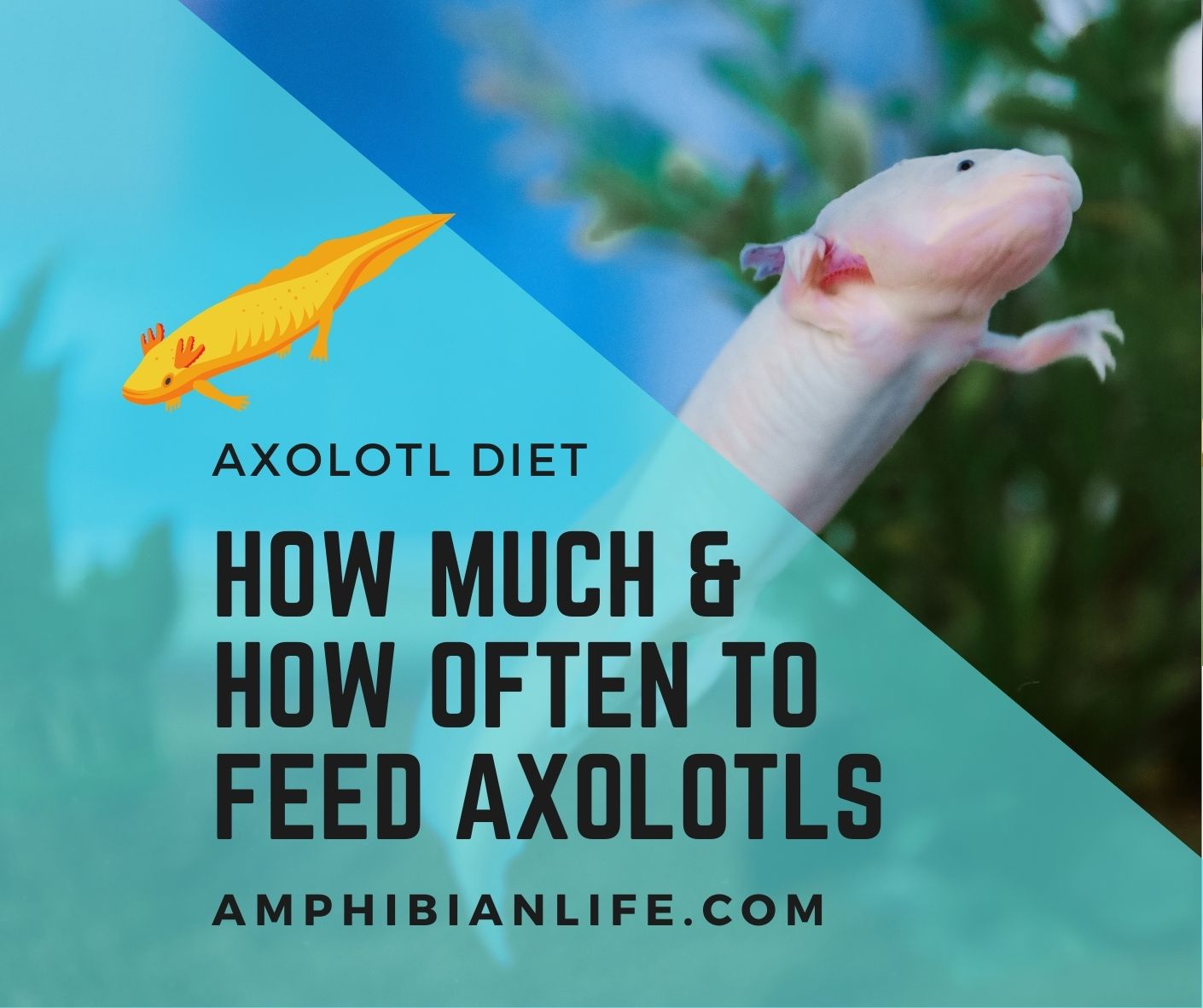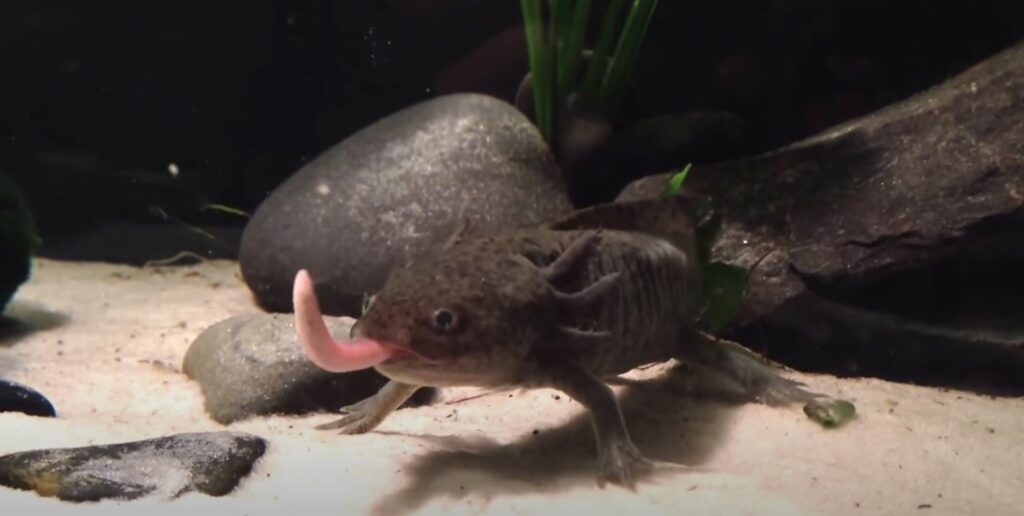
Axolotls are the group of Amphibians also classified as salamander or the Walking fish. Their habitat is native to the high-altitude body of water, for example, lakes. It’s surprising to know that Axolotls can eat basically anything that fits their mouth.
However, they strictly feed upon a carnivorous diet. From worms, small fishes, insects to salmon pellets and brine shrimp, there’s an array of food options for Axolotl. Though individuals taking care of Axolotl often question. How Much & How Often Do I Feed My Axolotl?
How Much Should I Feed my Axolotl?
If your Axolotl has suddenly stopped eating, you might run into a panic. However, there isn’t something to worry about, except the amount of food you feed them.
The amount of food an Axolotl will ideally require depends upon their size, maturity, age, and temperature.
While young Axolotls require eating once every single day, you can feed them a small bloodworm. Though for adult Axolotls, feed them two fishes or shrimps thrice a week.
Meanwhile, during high-temperature days when their metabolism is fast, Axolotls eat more. Whereas on colder days, they will eat less.

How Often to Feed Axolotl?
Digestion is an extremely slow process in Axolotls; thus, always look for the amount of food you are serving.
While young Axolotls can eat daily, make sure you precisely know the amount of food they require.
Likewise, in adult Axolotls, feeding twice or thrice a week is enough. Both overfeeding and underfeeding can lead to gastric problems. Or it can even generate bile formation around their stomach linings.
On the contrary, weather conditions play an important role in how much & how often should you feed Axolotl?
If it’s hot and humid, their digestive system will work faster, though digestion slowdowns during cold and dry weather.
For Further Reading
- Do Axolotls have Many Colors? ( And Why so Many)
- How Much Axolotl cost? What about accessories?
- How to Feed Worms to Axolotl? A Guide to Worm Farming.
How to Feed Axolotl?
You cannot simply throw food in the Axolotl tank and expect them to eat it. Simply take a worm/ pellet or small fish in a tong and wiggle it in Infront of your Axolotl’s mouth. Let them catch their own prey.
What is the best time to feed Axolotl?
Axolotls like eating at night and are not specified in a mood to eat during the day. Pay attention to their food habits as a lot of Axolotls like to eat during a specific hour each day.
If your Axolotl isn’t eating well, it may not always be a feeling of full but unspecific feeding hours.
What should I feed Axolotl?
What do you feed Axolotls? Several individuals often come up with the question, What Should I feed my Axolotl? The answer to it is quite simple. Axolotls can eat a wide variety of carnivorous food.
It may include freshwater shrimps, tadpoles, bloodworms, insects, small fishes, etc. Axolotls at wild depend upon the discussed food items, though one as a pet can rely on other options.
There is various convenient food, including raw beef meat, liver, and lamb heart. Though before feeding any of these meats, make sure all the fat of them is trimmed.
Axolotls have it a high time digesting fats and carbohydrates. Also, because Axolotls do not have teeth, thaw and mince the meat manually before feeding them.
What food should I avoid feeding Axolotl?
What Shouldn’t You Feed Axolotls? Axolotls will happily feed upon whatever food you offer them. Though as an alert and educated human, there are few exceptions you should learn.
- Avoid oily and fatty food.
- Avoid carbohydrates or excessive protein. Even though protein is essential for Axolotl’s growth, they might have a high time digesting if feed-in excess.
- Do not feed them anything that is big in size. Axolotls have a small mouth with no teeth at all. They will simply swallow small food items but might chock on anything bigger than their mouth.
- Do not feed them anything with a hard Exoskeleton. Axolotls can swallow such food items, but they will come out in whole instead of crossing the digestion process.
- Avoid processed or preserved meat. Anything that is loaded with chemicals, preservation, and artificial substances proves difficult for Axolotls to digest.
- Avoid serving Feeder fish to Axolotl. The statement is a little controversial amongst several experts, but avoid it as Feeder fish can transfer diseases and parasites. If you want to feed, make sure the fish are quarantined at least 30 days before you feed them.
- Do not feed them an herbivorous diet. You Axolotl may eat it without any fuss, but a plant-based diet will provide no nutrition to their growth.
How Long Can Axolotl Go Without Food?
Axolotl takes considerable time to digest, and thus they can easily go 2 to 3 days without eating. A well-fed adult Axolotl can go up to 3 weeks without any food. They won’t even suffer from the effect.
However, the condition is only ideal if the water temperature is below 15 degrees Celsius. If the temperature is above the level, you will need to feed them twice or thrice a week.
In contrast, feed baby Axolotls daily, ensuring they receive enough nutrition during their growing period.
Feeding an Axolotl is completely upon the individual. You can either feed them two or three times a week in moderation. Or feed them until full, and they are good to go for the next two to three weeks.
How you want to feed your Axolotl is completely up to you. You can either feed it until it is full, and you should be good to go for two weeks at the very least. Feeding in moderation is marked safer.
Why if my Axolotl not eating?
If your Axolotl has stopped eating, there could be several reasons responsible for that.
The first and common reason can be weather/ temperature. Axolotls are subtropical and thus cannot handle high temperatures.
If the temperature reaches above 20 Degree Celsius, heat stress in Axolotl can lead to less eating. Further, with 24 Degree Celsius and above, the situation can prove deadly for Axolotls.
- Moving stress and a new environment are also responsible if your Axolotl is not eating.
- They will not eat if the food item is too hard, too big or have some artificial flavour (salt or sweet).
- They can refuse to eat due to aggressive tankmates.
- Intestinal parasites can make Axolotl throw up and not eat for weeks. In such cases, contact a veterinarian immediately.
- If they have ingested something like gravel and sand, Axolotl can avoid eating. Sometimes the problem will itself go away, but it becomes vital to meet a veterinarian at times.
- Axolotl likes to live in clean water, and if your water tank is dirty or stinking, they will refuse to eat.
- Overeating can slow down their digestion process, resulting in less eating amongst Axolotl.
How to Tell if Axolotls are Overfed?
Axolotls are opportunistic eaters and thus will eat anything available in their tanks. Though as an owner, you have to make sure they aren’t overfed.
There’s a simple thumb rule that will help you limit overfeeding in Axolotls. So, How To Avoid Overfeeding Axolotl?
Axolotl’s head and belly are near the same size. If the belly of your Axolotl is getting bigger than their head, you are overfeeding him.
It is very easy to notice the change as their belly holds food for an extended period due to slower digestion.
Another hack- If your Axolotl is floating instead of swimming, it is because you have overfed them.
If you feel like Axolotl is not interested in eating, avoid forcing them. Never force food into their mouth, or they may end up getting sick. Overfeeding in Axolotls can lead to several harmful ailments, specifically digestive problems.
How to tell if Axolotls are Underfed?
Similarly, like Overfeeding, you can determine underfeeding amongst Axolotls depending upon their belly size. If their belly is not as wide and plump as their head, Axolotls are underfed. Though do not mistake plump with obese.
How often does an Axolotl poop?
Axolotls poop solid stool within a day or 2 of eating. Because they have a slow metabolism, they may not poop daily.
What does Newly Hatched Axolotl eat?
A newly hatched Axolotl will feed upon their pouch for the first 48 hours. Their pouch is basically a yolk sac attached to their stomach.
Once the Yolk Sac is exhausted, baby Axolotl will eat algae, waste, and remains of trout & salmon. Or they can also attack small larvae.
Will axolotls stop eating when full?
Where some Axolotls aren’t mindful eaters, some will stop eating when they are full. However, as an amphibian owner, you should control their food.
Do Axolotls need vitamin or mineral supplements?
Axolotls are dependent upon food that is rich in nutrients (Vitamin and Minerals). Everything they eat, from nightcrawlers to fish and worms, is rich in vital nutrients.
Axolotls would not need Vitamin and Mineral supplements until you feed them poorly or on an herbivorous diet.
In case of necessity, feed them complete food/superfoods that are available in the supermarket/ pet store. You can search them with names like, ‘Complete food for Axolotls’ and more.
How many pellets Should I Feed My Axolotl?
There is no specific count of how many pellets should feed your Axolotl.
While introducing them with Pellets, feed them nearly 5 or 6 at first. Adult Axolotl can eat even a dozen pellets.
Now figure how many have they ate, and for the next time, remove two from the count.
Always choose the right size of Pellets that are easy to swallow. If you have big Axolotl, consider crushing them in half.
Conclusion
Depending upon how young or old your Axolotl is, always feed them in moderation. Feeding frequency for Axolotls depends upon their age and size.
While a young Axolotl will require feeding daily, an adult Axolotl must be feed twice a week.
If you are a new Axolotl parent, always begin with feeding smaller to intermediate portions. Every portion must have food that they can eat in 5 minutes.
Lesser the portion after that and monitor how much they eat. Shortly you will figure out how much to feed your Axolotl.
